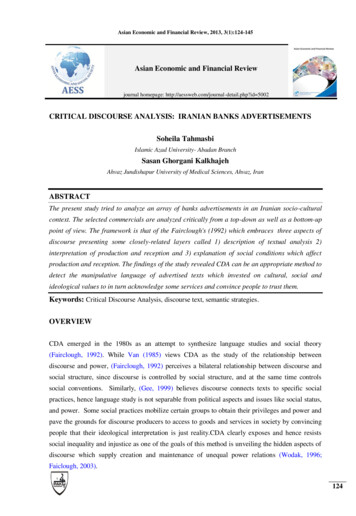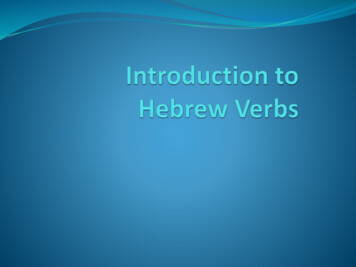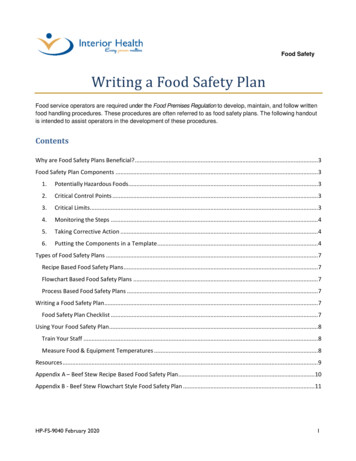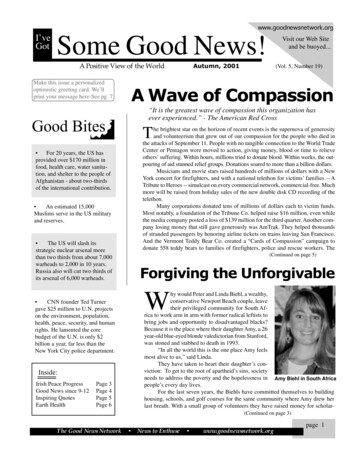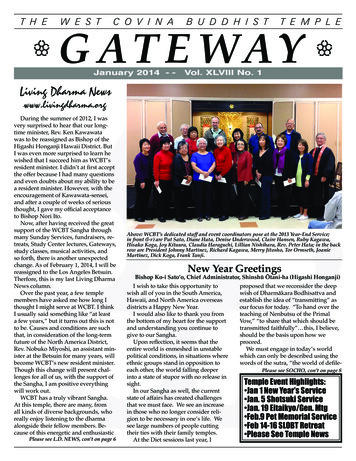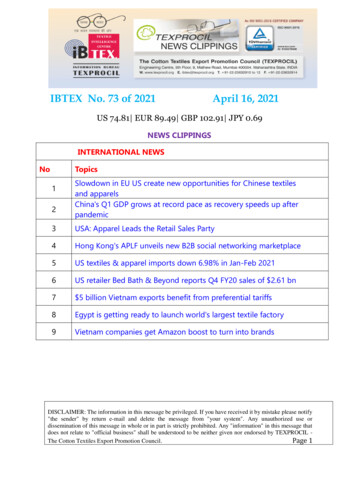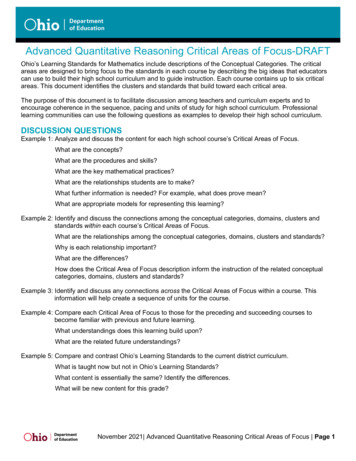
Transcription
ISSN 1799-2591Theory and Practice in Language Studies, Vol. 8, No. 4, pp. 433-444, April 2018DOI: http://dx.doi.org/10.17507/tpls.0804.11Critical Discourse Analysis of News Reports—Based on the Guardian News Report of China’sMilitary Parade to Mark the 70 Years of SecondWorld WarXinling TianChongqing Normal University, ChinaAbstract—Critical Discourse Analysis (abbreviated as CDA below), was firstly introduced by an Englishlinguist, Norman Fairclough in the late 1980s. And CDA mainly focuses on public and non-literature discourseand it mainly applies Halliday’s Systematic Functional Grammar (abbreviated as SFG below). Since Chinaannounced the decision of holding a military parade to celebrate the 70’s anniversary of WWII victory,massive negative voices among the international society have been crowding in on China. Therefore, thepresent study was prompted to focus on the news report of China’s military parade to celebrate the victory ofWWII from the Guardian, and use Fairclough’s Three-Dimensional Model of CDA as theoretical frameworkand apply Halliday’s SFG as analytic tools to study two questions: How does the reporter insert his ideology inthe news text of the Guardian news report on China’s Military Parade to Mark the 70 Years of Second WorldWar? What kinds of the social and historical ideologies bear in and account for the news? Through theanalysis, it finds that Guardian’s reports overemphasize and over interpret the negative influences of parade.Index Terms—critical discourse analysis, news report, ideology, China’s Military ParadeI. INTRODUCTIONA. Research BackgroundWith the rapid economic development for several decades, every aspect of China, from micro social problems as wellas every big move, has been drawing increasing attention from the world. “Media discourse is the main source ofpeople’s knowledge, attitudes and ideologies, both of elites as well as of ordinary citizens.”(Van Dijk, 1993, P36).Hence, it is very important to study China’s images in western medias and how ideology influences and bears inlanguage.China held a ceremonial military parade to celebrate the 70th anniversary of the victory in the Chinese People’s Warof Resistance Against Japanese Aggression and the World Anti-Fascist War on Sep. 3rd 2015, which had attracted theworld major medias’ reports, however, the massive criticism outnumbered the positive messages of the parade andcelebration. Seemingly, the rest of the world was hostilely over-interpreting this celebration. Negative comments andunpeaceful information were the main theme in multiples of world’s media reports and editorials. However, to manyordinary Chinese, they felt excited, proud, and the old generation and veterans who were gone through that part ofhistory were deeply touched and shed tears.Apparently, the observers, commentators and reporters around the world had a difficulty in seeing eye to eye witheven an ordinary Chinese on China’s military parade to mark 70th anniversary of the World War II. Even before the bigevent, many articles released online with analysis of the behind meaning in China’s military parade were foreshadowingthe enormous negative voices from the international community. The report on THE DIPLOMA was titled as China’sMilitary Parade: A Warning to Japan and the US. Simultaneously, over the Pacific Ocean, CNN mainly focused on thecomparison on global military force between China and the USA by citing table and pie chart from authority andinstitute, highlighting the lockdown in Beijing and the prohibition on entertainment broadcast. The Financial Timeseditorial displayed the attitude of criticism in the first paragraph; “China’s rise as a regional hegemony and a bluntwarning to the USA (Pomp, Circumstance and Combat Vehicles at Beijing Parade, The Financial Times)” and let alonethe large quantities of critical quotations from the other observers and scholars in the article.A report from Daily Mail, with the sentence “locals are banned from watching” in its news title prompted a hotdiscussion on Sina Weibo. Several comments and discussions with strong sentiments flowed in the blog. Many Chinesenetizens showed drastic disapproval of the deliberate emphasis in this piece of news, arguing medias abroad reportedthis event with prejudices. One compatriot’s comment on Daily Mail’s message board evoked strong resonance amongnetizens on Sina Weibo.B. Research Questions 2018 ACADEMY PUBLICATION
434THEORY AND PRACTICE IN LANGUAGE STUDIESThe year of 2015 meaningfully flagged the 70th anniversary of the victory of the World War Second. As a member ofthe Allies and mainstay against Japanese Fascist in Asian battlefield in WWII, China held a celebration includingactivities of a reception, an evening gala and a military parade to celebrate the victory in the Chinese People’s War ofResistance Against Japanese Aggression and the World Anti-Fascist War. For most Chinese, since it was a memorableand exciting event, they felt proud and strong ethos and all the reports and news covers were exactly the same way.However, English majors who utilize news reports to study English may encounter totally reversed reports, most ofwhich were criticisms and negative information, totally different from what they had read from the domestic medias.Why medias abroad attacked China on such a big event on the victory day.Based on this event and these phenomena, CDA and SFG will be conducted in this paper to investigate questions asfollow:⑴How does the reporter insert his ideology in the news text of the Guardian news report on China’s Military Paradeto Mark the 70 Years of Second World War?⑵What kinds of the social and historical ideologies bear in and account for the news?II. LITERATURE REVIEWSince CDA is the basis of the whole study, firstly, a brief introduction will be drawn on CDA in this chapter. Then,Fairclough’s Three-Dimensional Model and Halliday’s Systemic-Functional Grammar serving as the theoreticalframework and methodology of this paper will be detailed respectively. The literatures are surveyed to display theresearch and development on CDA from home and abroad in the following two parts. Afterwards, for CDA studies theabuse of power and hiding of ideology in language, the literature and research of ideology and power in language arereviewed to complete the theoretical basis of this thesis and then the connections between CDA and media discoursewill be studied. At last the related CDA study on news reports with SFG was reviewed to show the hints of the presentstudy.A. An Introduction of Critical Discourse AnalysisAs a newly-developing discourse analysis in the late of 1980s, CDA has been attracting an increasing attention ofscholars from home and abroad. “Critical Linguistics” was firstly mentioned by Fowler in his book Language andControl published in 1979. Then ten years later, the term of Critical Discourse Analysis (CDA) was initially introducedby the English linguist, Norman Fairclough in his work Language and Power. “Critical Linguistics” is also calledCritical Discourse Analysis. In China, majority of professors and scholars agree the standpoint that the two terms, CLand CDA refer to the same notion (Chen Zhonghua et al.,2002). In this dissertation, all the quotations and mentions ofterm CL are equally regarded as CDA.Some Chinese representatives of this field define that CDA linguists disclose the complex relations among language,power, politics, social and historical ideology and decode how the injustice, inequality, political hegemony andideological prejudice subconsciously spread through discourses mainly by studying the characteristics of discourses andthe social and historical background of discourse.Fairclough’s Three-dimensional ModelFairclough’s Three-Dimensional Model has been a central theoretical framework for CDA linguists. As aninterdisciplinary study, CDA highlights that the analysis of text can not be isolated from the discursive practice and thesocial context where it is produced.B.Figure1. (Fairclough 1989)Fairclough illustrated the idea of discursive practice as a social practice within a diagram. It indicates: text is productof discursive practice or interaction process, and this practice includes the production and distribution and consumptionof text, all which are all decided by condition of social practice (Xin Bin,2005). Early in 1989, Fairclough took thediscourse as three dimensions: texts, interactions and contexts. Based on the three dimensions, he developed threestages or aspects of critical discourse analysis, description, interpretation and explanation:⑴Description is the stage which is concerned with the formal properties of text, such as properties of vocabulary; 2018 ACADEMY PUBLICATION
THEORY AND PRACTICE IN LANGUAGE STUDIES435textual structure.⑵Interpretation is concerned with the relationship between text and interaction with seeing the text as a product of aprocess of production, and as a resource in the process of interpretation.⑶Explanation is concerned with the relationship between interaction and social context, with the socialdetermination of the process of production and interpretation and their social effect(Fairclough,Norman,1989).The three dimensions could be illustrated in this following figure:Figure2. Discourse as text, interaction and context (Fairclough,1992A)We can understand the relationship between discourse and the three factors in the diagram as follow: firstly, it is thediscourse as text of written and spoken language which contains formal properties like grammar and vocabulary.Secondly, it is discourse as discursive practice including the processes of production and interpretation of text, whichmeans when analyze the language of text, the way discourse production and interpretation in society should be takeninto consideration. The last one is discourse as social practice, which emphasizes that the analysis of language use intext and the processes of production and interpretation should be put into the corresponding social context.Later in 1992, he combined the three conceptions of discourse with the three stages or aspects, and applied theseaspects to in CDA of discourse.Figure3.A three-dimensional view of discourse analysis(Fairclough,1992A)The conception of CDA and these three dimensions were explained in his book published in 1992. According to XinBin, that is to say “to describe formal properties of text, to interpret the relationship between text and interaction, and toexplain the relationship between interaction and social context.” (Xin Bin,2005,P55).Fairclough noted “Each discursive event has three dimensions or facets: it is a spoken or written language text, it isan instance of discourse practice involving the production and interpretation of text, and it is a piece of social practice.”(Fairclough,1993,P133). To sum up, when employing CDA into discourse, all the analysis of linguistic features,production and interpretation of text should be cast into its relevant context, because one of the main principle of CDAis that discourse is a social action.Halliday’s Systemic-functional Grammar“CDA is regarded as an instrumental linguistics.”(Folwer,R.1991,P481) According to Xin Bin, “CDA takes languageas a muti-functional system” (Xin Bin,2005,P55), which shares the same ground with the Halliday’sSystemic-Functional Grammar to regard language as a reflection of its function. Therefore, SFG constitutes the mainmethodology resource of CDA.The unique form of language grammar system is closely related to the social and personal need of language (Halliday,1971), which means that language must fulfill the three needs of its users. According to him, the three fundamentalfunctions of language were proposed as follow in 1971:C. 2018 ACADEMY PUBLICATION
436THEORY AND PRACTICE IN LANGUAGE STUDIES(1) ideational function which is “language serves for the expression of content it is through this function that thespeaker or writer embodies in language his experience of the phenomena of the real world; and this includes hisexperience of the internal world of his own consciousness: his reactions, cognition, and perceptions, and also hislinguistic acts of speaking and understanding.(2) interpersonal function which is the expression of his comments, his attitudes, and evaluation, and also therelationship that he sets up between himself and his listener-in particular the communication role that he adopts, ofinforming, questioning, greeting, persuading (3) textual function which is “in turn instrumental to these two, whereby language is, as it were, enable to meet thedemands that are made on it it is concerned with the creation of text.it is through this function that language makeslinks with itself and with the situations; and discourse becomes possible, because the speaker or writer can produce atext and the listener or reader can recognize one.”(Halliday, 1971, P332-334).Generally speaking, the ideational function is language’s function as an expression of experience of the real worldand the speaker’s or writer’s inner world; the interpersonal function is language’s communicative function, whichestablishes, maintains and reflects the speaker’s or writer’s social relationships with others; the textual function is thefunction that the transfers of information and language compose a coherent and discursive text associated with its socialand communicative context. Briefly speaking, language works as a construction of people’s knowledge and thoughtsystem through the ideational function and forms social relationships between subjects by the interpersonal function.These metafunctions could be applied to explain the language intervention into society.D. CDA Studies Abroad and at Home and Related CDA Studies on News Reports from Transitivity SystemAffected by the “critical theory” in Western Marxism and in response to the long-dominant structural linguistics withrepresentatives like Saussure and Bloomfield who regarded linguistic school as an abstractly self-contained andself-sufficient system, avoiding to cut off its connections to other disciplines like sociology, CL was conceived and laidthe emphasis on one point that “disclose ideology hidden in the discourse text by analysis of society from languagelinguistics, application proper linguistic methodology and association with the historical and social background.” (ChenZhongzhu et al.1995, P21).With such a critical trend, myriads of English linguists emerging focus on the non-literary discourse-public andmedia discourse in the late 1970s. “Critical Linguistics” was firstly mentioned by Fowler and some other linguists fromthe University of Anglia in the book Language and Control published in 1979 in which, they applied critical approachto analyze language in different discourse from news reports to regulations to study the interaction between ideologyand discourse. Then after proposal of CDA for the first time in the book of Language and Power, Fairclough (1993)viewed discourse is use of language seen as a form of social practice. It is worthwhile noticing that the word “critical”in CDA carries no regular meaning of criticizing, picking flaws or complaining, instead “it aims to change or evenremove what is considered to be a false or distorted consciousness and to render transparent what had previously beenhidden. In so doing it initiates a process of self-reflection in individuals or in groups so as to achieve liberation from thedomination of past constraints.” (Connerton, 1976, P20).Fairclough (1993) spilled out the purpose of the CDA by defining it as a discourse analysis which “aims tosystematically explore often opaque relationships of causality and determination among discursive practices, events andtexts, and wider social and cultural structures, relations and processes; to investigate how such practices, events andtexts arise out of and are ideologically shaped by relations of power and struggles over power, and to explore how theopacity of these relationships between discourse and society itself as a factor secure power and hegemony.” (Fairclough,1993, P135).The another prominent contribution of Fairclough(1993) lies in that he puts forward and applied the usethree-dimensional framework to discourse analysis for the first time, which serves as a theoretical and methodologicalguide for CDA practitioners. He held a viewpoint that each discursive event has three dimensions or facets: it is aspoken or written language text, it is an instance of discourse practice involving the production and interpretation of text,and it is a piece of social practice.The most recently literature from Van Dijk(1993) defined CDA as “a type of discourse analytical research thatprimarily studies the way social power abuse, dominance, and inequality are enacted, reproduced, and resisted by textand talk in the social and political context. With such dissident research, CDA analysts take explicit position, and thuswant to understand, expose, and intimately resist social inequality.” (Van Dijk, 1993, P374).Comparing to the studies abroad, CDA in China needs catch up a little bit, starting with scholar Chen Zhongzhu in1995. Due to the research blank, a growing number of domestic scholars have concentrated on the study of CDA. Withthe ardent research and arduous efforts, CDA studies in China had taken shape and deeply entered into a new course.“The CDA development in China characterizes articles published in academic journalisms.”(Ji Weining, 2006, P114).The articles could roughly be divided into four genres: (1) introduction of CDA theories (2) research on methodology ofCDA (3) case study and application of CDA (4) interdisciplinary studies of CDA.From the aspect of linguistics and philosophy, many Chinese scholars explained and illustrated the theories andmethodology of CDA. The main ideas and methodology and the relationships among language, power, and ideologywere generally introduced by Xin Bin (1996). Xin Bin (2005) concisely illustrated the methodology of CDA in Englishnews, emphasizing to pay special attention to the social and ideological factors in its production, distribution, and 2018 ACADEMY PUBLICATION
THEORY AND PRACTICE IN LANGUAGE STUDIES437interpretation.The publication of Xin Bin’s book (2005) helps to stretch the CDA studies in China to a new stage. In the book, hediscussed language use in power and ideology and illustrated the methodology of CDA and application of CDA in newsreports analysis. CL studies the relationships among language, power, ideology. It regards the text as the result of choicefrom the aspects of linguistic structure and ideology. And the most important theoretical basis and methodology comefrom the systematic functional grammar by Halliday (Xin Bin, 2005).Under the theory of CDA, transitivity system in SFG is applied as methodology of present study, the studies oftransitivity analysis of news reports will be survey in this session to display its effectiveness, and the methodology ofpresent study will be explained in details in the following chapter.On 4th July of 1986, the local court in Birmingham declared the innocent verdict of the policeman who accidentallyshot the suspect’s five-year-old son in sleep to death in 1985. At that night, BBC news reviewed the death of the boy,“the boy died when the policeman’s gun went off”. In the first place, BBC should have regarded this tragedy as amaterial process, reported it as other medias like “the policeman shot the boy” or “the boy was shot dead by thepoliceman”; however, BBC broke this event into two processes, avoiding the causal conjunctions such as because butusing “when” to connect the two processes, therefore, the boy was no longer a victim but actor of the action “sleep”; thefact “the policeman shot” was downplaying as it was in the position of clause; the selection of verb “went off” turnedthe actor of action process into guns instead of the policeman(Xin Bin,2005). The selectivity in news reports can berealized through the choice of different processes, what’s more, by investigating the linguistic features of theseprocesses, the explicit and implicit ideology in news reports will be decoded, which hints a directions of present study.E. Power in Language and Ideology in LanguageSince CDA focuses on the language and ideology hidden in text, that is to say to study how use of language is appliedto serve power order and power struggle in our society. Foucault used to say that “where there is discourse, there ispower”. CDA linguists deem discourse as a social practice, which means “first, the language is a part of society, and notsomehow external to it. Secondly, that language is a social process. And thirdly, that language is a socially conditionedprocess, conditioned that is by other (non-linguistic) parts of society.” (Fairclough, 1989, P22). Therefore, it decides thatbehind the discourse the whole social order of discourse composes together as a hidden effect of power (Fairclough,1989). “Order of discourse refers to the specific texts in certain social field and institution, which composes andsupports the social order.” (Xin Bin, 2005, P31).Fairclough used to criticize the conversational analysis, commenting that this kind of discourse analysis takes thecontrol of power for granted. Hence, Fairclough(1992A) himself, thinks “the realization of controlling and theeffectiveness of resistance depend on people developing a critical consciousness and its modalities, and challenging themediator’s positioning rather than just obeying it without questioning.” (Fairclough,1992A,P8) That’s what CDA paysattention to, language and ideology go hand in hand, and together they serve the power, building, consolidating anddisorganizing the power system in our society.The main task of CDA is to decode the associations among language, ideology and power. According to ChangChangfu (1998), ideology is “the ruling ideas of the ruling class, which puts emphasis on the relationships betweenacquired economic interests and the law, religion and philosophy which are shaped by it and serve it.” (Chang Changfu,1998, P229) “ideology essentially attempts to disguise the relations in reality, which is a reverse and mysteriousreflection of the reality.” (Yu Jingwu, 1993, P161). However, in the field of CDA, scholars hold a different view, andthey regard ideology as a neutral concept. Fowler (1991) deems it as “the sum of ways in which people both live andrepresent to themselves their relationship to the conditions of their existence.” (Fowler, 1991, P92). Kress and Hodgesees the ideology as a descriptive conception, viewing it as an ideological system organized from certain specificstandpoint, which includes not only distorted political attitudes and theories but also science and metaphysics (Xin Bin,2005).Thus, according to these reviews, ideology is something concealed and organized, so the informational formalityof it could help to carry and spread ideology itself, which is what CDA tries to decode and reveal, the implicit ideologyhidden in language.F. Media Discourse and CDAThompson (1990) points out, that analysis of ideology in modern society must be sufficiently aware of the mainfunctions of mass media’s nature and effectiveness in the production and distribution of ideology. Since CDA was born,critical linguists have been attaching great importance on the analysis of the non-literal discourse. Media discourse,together with other mass discourse like advertisements and official fields consists of the analytical projects of CDA. Sofar, media discourse has been topping the list all the time. Media discourse, as an outcome of a social practice, newsreports, like the other discourse, contain or demonstrate the reporters’ viewpoints and stands. Therefore, there is nopossibility that media discourse could absolutely objectively reflect and report the reality and society. As Geis has putforward, maybe the most significant right news media possesses is that it decides what question is important at whattime and whose voice on what question should be reported (Xin Bin, 2005). That is to say media discourse and newsreports is selective. Nowadays, mass media using English as a mediator has been penetrating every aspect of social life;“hegemony” sprouting from English and language culture has been becoming increasingly obvious; News reports inEnglish dominate the world voice, even affect and control the public thought and awareness (Xin Bin,2005). For this 2018 ACADEMY PUBLICATION
438THEORY AND PRACTICE IN LANGUAGE STUDIESreason, there is a need to apply CDA to news by analyzing the linguistic features, interpreting it from the social andhistorical background, to reveal the unaware ideology hidden in language; simultaneously, it helps to improve languageawareness and critical thinking of readers.III. METHODOLOGY OF PRESENT STUDYA. Methodology and Analytic Tools of Present StudyPresent study is mainly conducted by the application of Halliday’s SFG as a methodology under the theoreticalguidance of CDA and focuses on analyzing the linguistic features in the material, rational and verbal processes fromtransitivity system as the ideational function of discourse in the Gurdian’s news report about China’s WWII celebrationand decoding the intertextuality of news by closely investigating the sources of these quotations. Hopefully, byanalyzing the linguistic features from transitivity as an aspect of description, the production and interpretation of thenews text and the explanation associated with social and historical background will be elucidated and the laden ideologywithin the news will be decoded. The answers would find all the proposed questions correspondingly.B. Transitivity“There are four aspects of English in discourse may contain ideology; they are the classification, transitivity,modality and transformation of discourse.” (Xin Bin, 2005, P65). Halliday regarded the semanteme instead of thesyntax as the basis of language to describe the real world, which means to study the ideational functions of differentprocesses in text from the semantic system. Fairclough (1992B) defined transitivity as “the systemic linguistic term forexploring the ideational functional of grammar at the level of the clause.” (Fairclough, 1992B, P177).Halliday deemed that reality is made up of process, consisting of “goings-on”: happening, doing, sensing, meaning,being and becoming. All of them are sorted out in the grammar of the clause which is the mode of action and reflection.The transitivity system construes the world of experience into a manageable set of process types: material process,mental process, relational process, behavioral process, verbal process and existential process. A process consists, inparticular, of three components: the process itself, participants in the process and circumstance associated with theprocess. Those elements are expressed in the linguistic level as follow: processes by the verbal groups; participants bynominal group; and circumstances by adverbial groups or prepositional phrases.The motherparticipantnominal nceverbal groupnominal groupadverbial groupClause as process, participant and circumstanceat homecircumstancePrepositional phrase“System of transitivity makes options available, and which process type is chosen to signify a real process may be ofcultural, political or ideological significance” (Fairclough,1992B,P180), which means that selection of different type ofprocesses and placement of participants and circumstances are closely associated the writters’ or speakers’ inclination,ideology and social and historical context.C. Processes of Transitivity in the Present Study1. Material Process“Material process is the process of doing.”(Halliday, 1994, P103). He explains the notion that some entities “do”something which may be done “to” some other entities. Material processes are not only physical events but also abstractdoing or happening. The verb indicates the process, and the logical subject is named as “Actor” and the direct object iscalled “Goal”; similarly, the Actor and Goal may also be abstract entity or non-human. One point should be made clearthat sometimes for certain language effects, the Actor may not be always appearing in the clause by employing passivevoice. Thus, the emphasis of Goal will be achieved.the police (Actor)the black man(Goal)shoot at (process)the black man(Goal)was shoot(process)by the police(Actor)Material process and passive material process2. Relational ProcessRelational process is the process of “being”, which intends to form a relationship between two participants withoutimplying that one participant influence the other in any way. According to Halliday, there are two modes of relationalprocess: attributive and identifying. Briefly speaking, attributive mode is that a participant has certain quality and insentence this quality is an attribute, then the participant who carries this quality is called carrier. For example, James isknowledgeable. And identifying mode is identical properties of two entities; the identified and identifier refer to thesame participants; for example Mary is teacher.Another classification of relational process by Halliday is intensive (A is a), circumstantial (A is in, at, under, for,with a), possessive (A has a). These two classification can be interflowing, seeing the following chart: 2018 ACADEMY PUBLICATION
THEORY AND PRACTICE IN LANGUAGE ircumstantialMark is smartThe book is on the tableMike is the leaderTomorrow is V-DAYThe leader is MikeV-day us tomorrowThe type of relational processesPossessiveThe ring is Mary’sThe book is mineMine is the book3. Verbal ProcessVerbal process is the process of “saying”, within any symbolic exchange of meaning. It can be directly or indirectlyquoted one. Three aspects of verbal process is namely, the particip
Systemic-Functional Grammar to regard language as a reflection of its function. Therefore, SFG constitutes the main methodology resource of CDA. The unique form of language grammar system is closely related to the social and personal need of language (Halliday, 1971), which means
